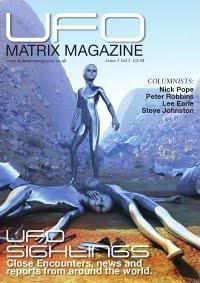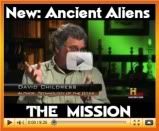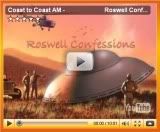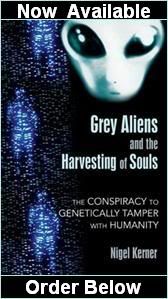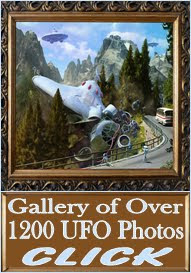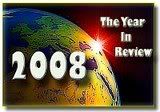Wednesday, January 21, 2015
130,000 PAGES OF UFO INVESTIGATION DOCUMENTS NOW ONLINE
Artist, William L. McDonald
The truth is out there - 130,000 pages of it. A massive amount of U.S. Air Force documents on alleged UFO sightings and investigations just went live on the Internet, thanks to this guy.
"I believe the documentation proves there is a cover-up going on. ... There's absolutely something out there."
That's John Greenewald - USA Today dubs him a "UFO enthusiast" and says he's spent almost 20 years filing Freedom of Information Act requests to obtain government files on UFOs.
He's now posted the documents on his website. They show that from 1947 to 1969, the Air Force documented more than 12,000 strange sightings, and 701 of them remain "unidentified."
It appears the cases were first documented after the alleged alien crash-landing in Roswell, New Mexico in 1947.
The investigation and documentation of these sightings was called Project Blue Book. But the U.S. Government said years ago it would no longer be looking into such cases, for a few reasons.
1) Because they didn't pose any threat to national security, 2) because there was no evidence of any extraterrestrial beings, and 3) funding.
But Greenewald doesn't buy that the investigations stopped. The docs are available online for all to see - you have to see to believe after all, right?
BLACK VAULT
PDF Link
http://projectbluebook.theblackvault.com/documents/1950s/1958%2001%206959705%20Albuquerque%20N%20M/1958-01-6959705-Albuquerque-N-M.pdf
Thursday, January 23, 2014
NASA ponders mysterious rock on Mars that suddenly appears
A mystery rock
on Mars that suddenly appeared in front of NASA's Opportunity rover may
look like a tasty donut, but it is like nothing ever seen on the
Martian surface before.
This before-and-after pair of images of the same patch of ground in front of NASA's Mars Rover Opportunity 13 days apart documents the arrival of a strange, bright rock at the scene. The rock, called "Pinnacle Island," is seen in the right image on Jan. 8, 2014. The image at left was taken on Dec. 26, 2013.
"It looks like a jelly donut," said Steve Squyres, the rover's lead scientist at Cornell University in Ithaca, N.Y., during a recent NASA event marking Opportunity's 10th year on Mars. "And it appeared, it just plain appeared, at that spot and we haven't driven over that spot." [Amazing Photos from NASA's Opportunity Mars Rover]
This before-and-after pair of images of the same patch of ground in front of NASA's Mars Rover Opportunity 13 days apart documents the arrival of a strange, bright rock at the scene. The rock, called "Pinnacle Island," is seen in the right image on Jan. 8, 2014. The image at left was taken on Dec. 26, 2013.
"It looks like a jelly donut," said Steve Squyres, the rover's lead scientist at Cornell University in Ithaca, N.Y., during a recent NASA event marking Opportunity's 10th year on Mars. "And it appeared, it just plain appeared, at that spot and we haven't driven over that spot." [Amazing Photos from NASA's Opportunity Mars Rover]
Wednesday, October 2, 2013
Smartest Aliens May Live Around Red Dwarf Stars
Robert Frost’s classic 1923 poem ”Nothing Golden Can Stay” is certainly true for planets that are in the habitable zone — or shall we say the golden zone — around their parent stars. A planet’s lease on life runs out when the evolving star grows too hot for the world hold onto water for sustaining life as we know it. With increasing stellar luminosity, the habitable zone sweeps outward beyond the planet’s orbital radius, leaving paradise worlds to bake to death as surviving extremophliles burrow underground. What’s sobering is that Earth has already spent 70 percent of its habitable years inside the sun’s golden zone. And it took that long for intelligent life to appear on the surface.
See complete article at Discovery.com - click link below........
Smartest Aliens May Live Around Red Dwarf Stars
Saturday, June 1, 2013
Friday, February 8, 2013
'Alien Earth' Study Suggests Milky Way Galaxy Holds 4.5 Billion Earth-Like Planets
By: Mike Wall
Published: 02/06/2013 11:10 AM EST on SPACE.com
Billions of Earth-like alien planets likely reside in our Milky Way galaxy, and the nearest such world may be just a stone's throw away in the cosmic scheme of things, a new study reports.
Astronomers have calculated that 6 percent of the galaxy's 75 billion or so red dwarfs — stars smaller and dimmer than the Earth's own sun — probably host habitable, roughly Earth-size planets. That works out to at least 4.5 billion such "alien Earths," the closest of which might be found a mere dozen light-years away, researchers said.
"We thought we would have to search vast distances to find an Earth-like planet," study lead author Courtney Dressing, of the Harvard-Smithsonian Center for Astrophysics (CfA), said in a statement. "Now we realize another Earth is probably in our own backyard, waiting to be spotted."
Read the entire article here .....
http://www.huffingtonpost.com/2013/02/06/alien-earth-milky-way-galaxy-earth-like-planets_n_2631063.html?ncid=webmail35
Also see ....
9 Exoplanets That Could Host Alien Life
Thursday, December 20, 2012
Another Potentially Habitable Planet Detected Around Nearby Star
A sun-like star in our solar system's backyard may host five planets, including one perhaps capable of supporting life as we know it, a new study reports.
Astronomers have detected five possible alien planets circling the star Tau Ceti, which is less than 12 light-years from Earth — a mere stone's throw in the cosmic scheme of things. One of the newfound worlds appears to orbit in Tau Ceti's habitable zone, a range of distances from a star where liquid water can exist on a planet's surface.
With a minimum mass just 4.3 times that of Earth, this potential planet would be the smallest yet found in the habitable zone of a sun-like star if it's confirmed, researchers said.
Read the whole story below at Space.com
Space.com
Thursday, November 8, 2012
SUPER-EARTH DISCOVERED IN STAR'S HABITABLE ZONE
This artist's impression shows HD40307g in the foreground, with its host star HD40307 and two other planets in the system. The depicted atmosphere and continents are not detected or constrained by this work.
The exoplanet is one of six believed to be orbiting a dwarf star 42 light-years from Earth.
The family of planets circling a relatively close dwarf star has grown to six, including a potential rocky world at least seven times more massive than Earth that is properly located for liquid water to exist on its surface, a condition believed to be necessary for life.
Scientists added three new planets to three discovered in 2008 orbiting an orange star called HD 40307, which is roughly three-quarters as massive as the sun and located about 42 light-years away in the constellation Pictor.
Of particular interest is the outermost planet, which is believed to fly around its parent star over 320 days, a distance that places it within HD 40307's so-called "habitable zone."
See entire story here below...
http://news.discovery.com/space/habitable-zone-exoplanet-super-earth-121107.html
Friday, October 5, 2012
Friday, March 2, 2012
Gary McKinnon not in the news today, but...........
NASA: We’ve Been Hacked Thousands Of Times Because Of Inadequate IT Infrastructure
Devin Coldewey
Paul Martin, NASA’s Inspector General, gave written testimony in a House committee earlier this week detailing the security threats faced by their IT infrastructure. The thrust of the document is that NASA needs to double down on cybersecurity but, naturally, needs more money to do so.
Their IT budget is $1.5 billion, but of that only $58 million was spent on security. Considering the enormous network of datacenters, laptops, operations centers, and research labs scattered around the world, this may not be nearly enough. As it is, in the last two years NASA has been hacked thousands of times. In one instance, the hackers gained full access to some NASA systems and credentials for 150 employees.
See entire story here at Tech Crunch >> http://techcrunch.com/2012/03/02/nasa-weve-been-hacked-thousands-of-times-because-of-inadequate-it-infrastructure/
Devin Coldewey
Paul Martin, NASA’s Inspector General, gave written testimony in a House committee earlier this week detailing the security threats faced by their IT infrastructure. The thrust of the document is that NASA needs to double down on cybersecurity but, naturally, needs more money to do so.
Their IT budget is $1.5 billion, but of that only $58 million was spent on security. Considering the enormous network of datacenters, laptops, operations centers, and research labs scattered around the world, this may not be nearly enough. As it is, in the last two years NASA has been hacked thousands of times. In one instance, the hackers gained full access to some NASA systems and credentials for 150 employees.
And to think that Gary did this 10 years ago to NASA - online - while on DIAL UP! Obviously, they've had a security problem for a very long time.
See entire story here at Tech Crunch >> http://techcrunch.com/2012/03/02/nasa-weve-been-hacked-thousands-of-times-because-of-inadequate-it-infrastructure/
Wednesday, December 7, 2011
EARTH'S TWIN? NASA's Kepler Mission Announces Latest Discovery
WATCH THIS ONE FIRST - THEN NASA VIDEO
The Kepler mission's science team announced its latest finding at a press conference on Monday, Dec. 5, 2011. The team announced the confirmation of Kepler-22b, its first planet found in the "habitable zone," the region where liquid water could exist on a planet's surface. The planet is about 2.4 times the radius of Earth, orbits around a star similar to our sun and is located 600 light-years away. Scientists don't yet know if Kepler-22b has a predominantly rocky, gaseous or liquid composition, but its discovery is a step closer to finding Earth-like planets. The planet's host star belongs to the same class as our sun, called G-type, although it is slightly smaller and cooler.
Kepler also has discovered 1,094 new planet candidates, nearly doubling its previously known count. Since the last catalog was released in February, the number of planet candidates identified by Kepler has increased by 89 percent and now totals 2,326. Of these, 207 are approximately Earth-size, 680 are super Earth-size, 1,181 are Neptune-size, 203 are Jupiter-size and 55 are larger than Jupiter. The findings, based on observations conducted May 2009 to September 2010, show a dramatic increase in the numbers of smaller-size planet candidates.
NASA
KEPLER-22B may be the most Earth-like world yet found in the galaxy — and it could be home to alien life.
It orbits a star like the Sun 600 light years — that's nearly 4,000BILLION MILES — away in the constellation Cygnus.
Importantly, the planet lies inside the habitable zone of its solar system, so-called because it is not too hot and not too cold for life to exist. Water — an essential requirement for life as we know it — would be a liquid.
Christmas would come around sooner there every year, because it takes just 290 days to go round its parent star.
Scientists cannot tell for sure yet whether Kepler-22b is a rocky world, a ball of gas or even a liquid object.
But its discovery, announced this week, suggests we're getting closer to discovering we're not alone in the universe.
The Kepler mission's science team announced its latest finding at a press conference on Monday, Dec. 5, 2011. The team announced the confirmation of Kepler-22b, its first planet found in the "habitable zone," the region where liquid water could exist on a planet's surface. The planet is about 2.4 times the radius of Earth, orbits around a star similar to our sun and is located 600 light-years away. Scientists don't yet know if Kepler-22b has a predominantly rocky, gaseous or liquid composition, but its discovery is a step closer to finding Earth-like planets. The planet's host star belongs to the same class as our sun, called G-type, although it is slightly smaller and cooler.
Kepler also has discovered 1,094 new planet candidates, nearly doubling its previously known count. Since the last catalog was released in February, the number of planet candidates identified by Kepler has increased by 89 percent and now totals 2,326. Of these, 207 are approximately Earth-size, 680 are super Earth-size, 1,181 are Neptune-size, 203 are Jupiter-size and 55 are larger than Jupiter. The findings, based on observations conducted May 2009 to September 2010, show a dramatic increase in the numbers of smaller-size planet candidates.
NASA
KEPLER-22B may be the most Earth-like world yet found in the galaxy — and it could be home to alien life.
It orbits a star like the Sun 600 light years — that's nearly 4,000BILLION MILES — away in the constellation Cygnus.
Importantly, the planet lies inside the habitable zone of its solar system, so-called because it is not too hot and not too cold for life to exist. Water — an essential requirement for life as we know it — would be a liquid.
Christmas would come around sooner there every year, because it takes just 290 days to go round its parent star.
Scientists cannot tell for sure yet whether Kepler-22b is a rocky world, a ball of gas or even a liquid object.
But its discovery, announced this week, suggests we're getting closer to discovering we're not alone in the universe.
Labels:
earths twin,
kepler 22b,
NASA
Subscribe to:
Posts (Atom)










